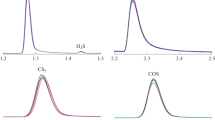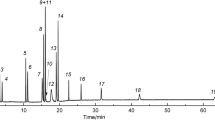Summary
Hydrocarbon multicomponent mixtures, obtained e.g. during investigation of reactions for petroleum processing or hydrocarbon synthesis, require a high degree of separation efficiency as well as the facility for covering a wide boiling range.
With an open tubular column coated with Polypropylenglycol (100 m×0.25 mm), which is suitable for this problem, various isothermal and temperature programmed separations were carried out.
This work is concerued with the resolution with respect to n-Paraffins (separation number) obtained in the various ranges of the chromatogramm by isothermal and temperature programmed operation.
With the isothermal operation, the separation number increases with increasing C-number; i.e. increases rapidly at the beginning with increasing partition ratio k and approaches for large k-values of 15 to 20 a maximum limiting value. The limiting value depends to a large extent on the working temperature, since it is mainly a function of the increase in retention per CH2-group, which decreases with temperature.
With temperature programmed operation a maximum is observed for separation number, which depends on the C-number. This is caused by the counter influence of the increase in separation number with C-number through increasing k values (increase in the front portion of the chromatogramm) and the decrease in separation number with temperature through a decreasing factor in retention per CH2-group.
The increase of peak width per unit time is proposed as a measure of the general separation quality of a separation column.
Zusammenfassung
Kohlenwasserstoff-Vielkomponentengemische, wie sie z. B. bei Untersuchungen über Reaktionen der Erdölverarbeitung oder der Kohlenwasserstoffsynthese erhalten werden, erfordern ein Höchstmaß an Trennleistung sowie die Erfassung möglichst weiter Siedebereiche.
Mit einer für diese Probleme gut geeigneten Filmkapillare (100 m×0,25 mm) mit Polypropylenglycol wurden isotherme und temperaturprogrammierte Trennungen ausgeführt.
Diese Arbeit beschreibt die auf die n-Paraffine bezogene Auflösung (Trennzahl) in den verschiedenen Chromatogrammbereichen bei isothermer und temperaturprogrammierter Arbeitsweise.
Bei isothermer Arbeitsweise steigt die Trennzahl mit steigender C-Zahl der n-Paraffine, d.h. mit steigendem Verteilungsverhältnis k zunächst stark an und nähert sich bei großen k-Werten von 15 bis 20 einem maximalen Grenzwert. Die Größe dieses Grenzwertes hängt stark von der Temperatur ab, da er in erster Linie eine Funktion des Faktors der Retentionszunahme pro CH2-Gruppe ist, der mit der Temperatur abnimmt. Bei temperaturprogrammiertem Arbeiten wird ein Maximum der Trennzahl in Abhängigkeit von C-Zahl beobachtet. Es wird verursacht durch die gegensinnigen Einflüsse der Erhöhung der Trennzahl mit der C-Zahl durch steigende k-Werte (Anstieg im vorderen Chromatogrammteil) und der Abnahme der Trennzahl mit der Temperatur durch einen abnehmenden Faktor der Retention pro CH2-Gruppe.
Als Kennzahl der allgemeinen Trennqualität einer Trennsäule wird anstelle der theoretischen bodenzahl der Zuwachs an Bandenbreite pro Zeit vorgeschlagen.
Sommaire
Les mélanges d'hydrocarbures, obtenus par exemple dans les recherches sur les réactions de transformation du pétrole ou de synthèse des hydrocarbures, exigent une excellente séparation, ainsi que la possibilité de faire des analyses dans un large domaine de points d'ébullition.
Différentes séparations — isotherme et en température programmée — ont été effectuées avec une colonne capillaire (100 m×0,25 mm) recouverte d'un film de Polypropylène-glycol, phase bien appropriée pour ce problème.
Ce travail traite des variations de la résolution des n-paraffines (en utilisant la puissance de séparation), dans les différents domaines des chromatogrammes obtenus en isotherme et en température programmée.
En isotherme, la puissance de séparation augmente avec le nombre d'atomes de carbone de la n-paraffine, c'est à dire croit d'abord très vite avec le facteur de capacité k, puis tend vers une valeur limite maximum, pour les grandes valeurs de k, comprises entre 15 et 20. La valeur de cette limite dépend beaucoup de la température de travail, car elle est en premier lieu une fonction du taux d'accroissement de la rétention par groupe CH2, qui diminue avec la température.
En température programmée, on observe un maximum de la puissance de séparation en fonction du nombre d'atomes de carbone. Cela est provoqué par les influences contraires de l'augmentation du nombre d'atomes de carbone résultant de l'augmentation de la valeur de k (ce qui se produit dans la première partie du chromatogramme) et de la diminution de la puissance de séparation lorsque la température augmente, diminution causée par une décroissance de la rétention par groupe CH2.
On propose comme mesure de la qualité générale d'une colonne l'augmentation de la largeur des pics en fonction du temps.
Similar content being viewed by others
Literatur
Fieser, L.F. undFieser, M., Lehrbuch der organ. Chemie, Verlag Chemie, Weinheim/Bergstraße 1954, S. 32.
Pichler, H., Schulz, H. undElstner, M., Brennstoff-Chemie48, 78 (1967).
Kaiser, R., Z. analyt. Chem.189, 1 (1962).
Hurell, R.A. undPerry, S. B., Nature196, 571 (1962).
Author information
Authors and Affiliations
Rights and permissions
About this article
Cite this article
Schulz, H., Reitemeyer, H.O. Temperature programmed capillary gas chromatography of complex hydrocarbon mixtures C3 to C16. Dependence of column efficiency (separation number) on C-number, temperature and heating rate. Chromatographia 1, 315–326 (1968). https://doi.org/10.1007/BF02257026
Received:
Accepted:
Published:
Issue Date:
DOI: https://doi.org/10.1007/BF02257026




